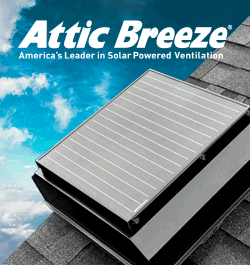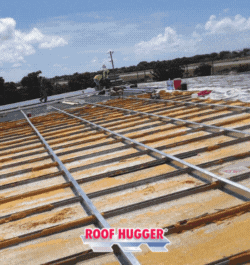Smart installs start here: Best practices for contractors
April 24, 2025 at 9:00 a.m.By Jesse Sanchez.
A few strategic moves can make or break solar ventilation installations — here’s what the pros know.
Contractors across the country are turning to Attic Breeze not just for its solar-powered ventilation products but also for the company’s deep bench of professional support and practical installation guidance. A closer look at Attic Breeze’s “Shared Best Practices” reveals more than just technical steps — it outlines a contractor-first mindset that prioritizes quality, efficiency and long-term performance.
The checklist begins before the fan is ever on the roof. The first best practice tip is simple but critical: check the product out of the box. “If the fan appears damaged, vibrates or something just doesn’t sound right, do not install the fan,” Attic Breeze advises. This early detection step can save contractors time, avoid warranty issues and ensure smooth installations.
From there, site selection takes center stage. Attic Breeze expresses the importance of sunlight, recommending installers position the fan and solar panel to face south whenever possible. If that’s not an option, adjust the panel to tilt southward. Even partial shade can cause performance to tank, the guide warns — casting a shadow means cutting off airflow power. In addition to maximizing sun exposure and avoiding shadows, another critical aspect of site selection is proximity of passive vents. Achieving full air changes in the attic is dependent on minimum spacing from existing vents.
Proper air intake is also a key factor. While the fans are designed to move significant amounts of air, they can’t function properly if the home isn’t ventilated well. That means clear soffits and passive vents are a must. Inadequate intake restricts airflow and reduces efficiency, which can ultimately impact customer satisfaction and system longevity.
Attic Breeze doesn’t stop at product advice. Through its Certified Installer Program, the company offers sales tools, marketing support and a dealer locator map to help pros grow their business. Certified contractors also gain access to exclusive digital tools like the Breeze Mate system and interactive design resources.
Manufactured in the USA using only the highest quality domestic and foreign parts.
Learn more about Attic Breeze in their Coffee Shop Directory or visit atticbreeze.com.

About Jesse
Jesse is a writer for The Coffee Shops. When he is not writing and learning about the roofing industry, he can be found powerlifting, playing saxophone or reading a good book.
























Comments
Leave a Reply
Have an account? Login to leave a comment!
Sign In